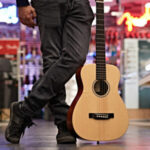Many bass players, especially those who favor 5-string models like the Fender 5-string bass guitar, often discuss challenges related to string tension, particularly on the lower B and E strings. Achieving optimal tension is crucial for playability, tone, and overall instrument responsiveness. Let’s explore some common concerns and effective solutions discussed within the bass community that can be applied to your Fender 5-string bass.
One of the first areas to consider is the strings themselves. The type and gauge of strings you use significantly impact string tension. Players often experiment with different brands and constructions to find what works best for their instrument and playing style. For instance, some bassists have found success with Ken Smith TCRML-5 strings, noting their balanced tension and comfortable feel. These are Taper Core-Medium Light strings, with specific gauges designed for a 5-string configuration.
Another factor related to string construction is the core type. Hex core strings are generally perceived as feeling tighter or stiffer compared to round core strings. Brands like DR DDT, known for their hex core construction, are often mentioned for their tuning stability and potentially higher tension. If you’re seeking increased tension on your Fender 5-string bass, exploring hex core string options could be beneficial. Conversely, experimenting with different gauges can also fine-tune the tension. One bassist considered trying a heavier gauge .145 D’Addario Pro Steel string to address tension issues, highlighting the direct impact of gauge on string feel.
Beyond strings, the hardware on your Fender 5-string bass guitar plays a critical role in string tension and overall performance. The bridge, in particular, is a key component. The stock bridge on some Fender models, like Mexican-made basses as mentioned in a forum discussion, might be a point for potential upgrade. Replacing the stock bridge with a higher quality option, such as a Gotoh 201 5-string bridge, is a modification many players consider.
A bridge upgrade can effectively increase string tension due to design differences that alter the string anchor points, sometimes positioning them slightly further back. This subtle change can have a noticeable impact on string feel and tension, improving the responsiveness of your Fender 5-string bass. Moreover, upgrading to a robust bridge like a Gotoh can enhance the overall stability and reliability of the instrument.
Another hardware modification to consider for your Fender 5-string bass is the addition of string retainers, sometimes referred to as string trees or tension bars. Hipshot string retainers are a popular choice, known for their quality and effectiveness in increasing downward pressure on the strings at the headstock. This increased pressure contributes to better string tension and can improve tuning stability and sustain. While some Fender basses already feature string retainers on certain strings, adding retainers specifically for the B and E strings, or opting for a 5-string retainer bar, can be a worthwhile upgrade. High-end bass brands like Sadowsky and Lakland often incorporate 5-string retainers, underscoring their benefits for optimizing string tension across all strings on a 5-string bass guitar.
In conclusion, enhancing the performance of your Fender 5-string bass guitar, particularly in terms of string tension, can be achieved through a combination of strategic string selection and hardware upgrades. Experimenting with different string gauges and constructions, considering a bridge replacement with a Gotoh 201, and adding Hipshot string retainers are all viable options to explore. These modifications, often discussed and recommended within the bass playing community, can contribute to improved playability, tone, and overall satisfaction with your Fender 5-string bass.

